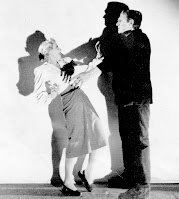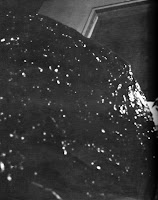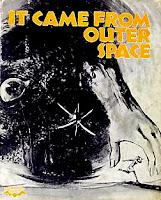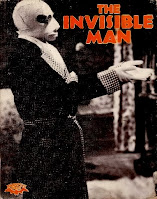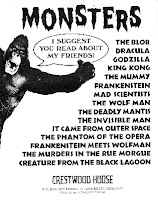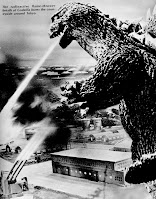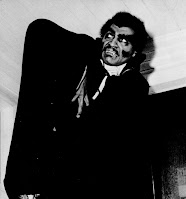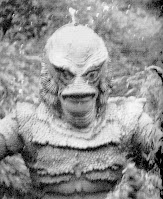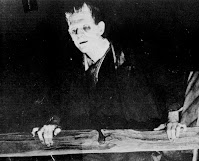by Ian Thorne, William R. Sanford, & Carl R. Green
1977-1987
Publisher: Crestwood House, Inc.
 For many monster fans growing up during the 1970s and early 1980s, the public library was a magical place filled with a nice collection of horror movie books for every ghoulie to snatch up and read about their favorite creature features. The Crestwood House Monster Series was a particular delight and unique in that they were published with the intent to be used by grade school libraries as educational tools for encouraging young people to read, as well as building their vocabulary and comprehension skills. In 1977, Elementary schools throughout the U.S. acquired a nifty boxed set of six different Crestwood House softcover books on Dracula, Frankenstein, Godzilla, King Kong, Mad Scientists, and The Wolf Man. The kit was called the "Monster Reading Center" and it also included a Teacher's Guide and audio cassettes to accompany each of these wonderful books.
For many monster fans growing up during the 1970s and early 1980s, the public library was a magical place filled with a nice collection of horror movie books for every ghoulie to snatch up and read about their favorite creature features. The Crestwood House Monster Series was a particular delight and unique in that they were published with the intent to be used by grade school libraries as educational tools for encouraging young people to read, as well as building their vocabulary and comprehension skills. In 1977, Elementary schools throughout the U.S. acquired a nifty boxed set of six different Crestwood House softcover books on Dracula, Frankenstein, Godzilla, King Kong, Mad Scientists, and The Wolf Man. The kit was called the "Monster Reading Center" and it also included a Teacher's Guide and audio cassettes to accompany each of these wonderful books. Fortunately, the Monsters Series were not maliciously being held captive by your school librarian. If you wanted to take one home, you simply had to browse the bookshelves and a nice, solid hardcover edition would be waiting for you to check out. And, if you found yourself competing with other horror enthusiasts attending your school, you could try finding these books at your local public library.
Fortunately, the Monsters Series were not maliciously being held captive by your school librarian. If you wanted to take one home, you simply had to browse the bookshelves and a nice, solid hardcover edition would be waiting for you to check out. And, if you found yourself competing with other horror enthusiasts attending your school, you could try finding these books at your local public library.By 1981, Crestwood House knew they had a good thing going and added The Mummy, Creature from the Black Lagoon, and Frankenstein Meets Wolfman to the series. The publishing company even offered two colored posters of The Mummy and Dracula, as well as bookmarkers (in packs of 30) for libraries to promote the collection.
 DRACULA (0913940747 Paperback / 0913940674 Library Bound; 1977 / 1982 / 1986). The creepy 1931 film version, starring Bela Lugosi as the King of the Vampires -- Count Dracula, is retold. Author Ian Thorne provides an enjoyably suspenseful narration for young readers, while classic movie stills help establish a visually eerie mood to the tale. Afterwards, we learn about the various sources that inspired Bram Stoker to write the famous novel the film was based on. From vampire folklore to historical background on Vlad Tepes, and a brief look at the blood-lapping habit of vampire bats, Thorne introduces a strange, but diverse world in which the vampire and its origins thrive. Further reading also mentions the heinous crimes of real-life Blood Countess -- Elizabeth Bathory. On the topic of movie vampires, Thorne hints that Nosferatu (1922) may not have been the first "Dracula" movie ever made, a fact rarely mentioned in other horror film books published during the 1970s and before. Other vampire films cited include London After Midnight (1927), Mark of the Vampire (1935), Dracula's Daughter (1936), Son of Dracula (1943), Bud Abbott and Lou Costello Meet Frankenstein (1948), Horror of Dracula (1958), The Last Man on Earth (1964), Count Yorga, Vampire (1970), The Omega Man (1971), The Return of Count Yorga (1971), Blacula (1972), The Night Stalker (1972), Scream Blacula Scream (1973), and Dracula (1974). Of course, Ian Thorne does not overlook one of the most beloved vampires of popular culture -- Grandpa, from the 1960's television series The Munsters. More still, Hungarian actor Bela Lugosi is discussed, and a map of old Transylvania is featured.
DRACULA (0913940747 Paperback / 0913940674 Library Bound; 1977 / 1982 / 1986). The creepy 1931 film version, starring Bela Lugosi as the King of the Vampires -- Count Dracula, is retold. Author Ian Thorne provides an enjoyably suspenseful narration for young readers, while classic movie stills help establish a visually eerie mood to the tale. Afterwards, we learn about the various sources that inspired Bram Stoker to write the famous novel the film was based on. From vampire folklore to historical background on Vlad Tepes, and a brief look at the blood-lapping habit of vampire bats, Thorne introduces a strange, but diverse world in which the vampire and its origins thrive. Further reading also mentions the heinous crimes of real-life Blood Countess -- Elizabeth Bathory. On the topic of movie vampires, Thorne hints that Nosferatu (1922) may not have been the first "Dracula" movie ever made, a fact rarely mentioned in other horror film books published during the 1970s and before. Other vampire films cited include London After Midnight (1927), Mark of the Vampire (1935), Dracula's Daughter (1936), Son of Dracula (1943), Bud Abbott and Lou Costello Meet Frankenstein (1948), Horror of Dracula (1958), The Last Man on Earth (1964), Count Yorga, Vampire (1970), The Omega Man (1971), The Return of Count Yorga (1971), Blacula (1972), The Night Stalker (1972), Scream Blacula Scream (1973), and Dracula (1974). Of course, Ian Thorne does not overlook one of the most beloved vampires of popular culture -- Grandpa, from the 1960's television series The Munsters. More still, Hungarian actor Bela Lugosi is discussed, and a map of old Transylvania is featured. FRANKENSTEIN (0913940739 Paperback / 0913940666 Library Bound; 1977 / 1978 / 1982 / 1986). The story of Universal Pictures' 1931 movie classic Frankenstein makes for a fun read as author Ian Thorne provides a chilling narrative about grave robbing and the living man created from parts of the dead, who is then misunderstood and forsaken by its own creator. Later, we also follow the tale of the 1970's made-for-television version, Frankenstein: The True Story, which was a more faithful adaption of Mary Wollstonecraft Shelley's 1818 novel both films were based on. Further reading provides information on the book's history and its author before straying into the world of the cinema and the various "Frankenstein" films that have been made -- beginning with Thomas Alva Edison's 1910 silent oddity. Displayed throughout the 47 pages are movie stills from Frankenstein (1910), Frankenstein (1931), Bride of Frankenstein (1935), Son of Frankenstein (1939), The Ghost of Frankenstein (1942), Frankenstein Meets the Wolf Man (1943), House of Frankenstein (1944), Bud Abbott and Lou Costello Meet Frankenstein (1948), The Curse of Frankenstein (1957), Frankenstein: The True Story (1973), and The Munsters TV series.
FRANKENSTEIN (0913940739 Paperback / 0913940666 Library Bound; 1977 / 1978 / 1982 / 1986). The story of Universal Pictures' 1931 movie classic Frankenstein makes for a fun read as author Ian Thorne provides a chilling narrative about grave robbing and the living man created from parts of the dead, who is then misunderstood and forsaken by its own creator. Later, we also follow the tale of the 1970's made-for-television version, Frankenstein: The True Story, which was a more faithful adaption of Mary Wollstonecraft Shelley's 1818 novel both films were based on. Further reading provides information on the book's history and its author before straying into the world of the cinema and the various "Frankenstein" films that have been made -- beginning with Thomas Alva Edison's 1910 silent oddity. Displayed throughout the 47 pages are movie stills from Frankenstein (1910), Frankenstein (1931), Bride of Frankenstein (1935), Son of Frankenstein (1939), The Ghost of Frankenstein (1942), Frankenstein Meets the Wolf Man (1943), House of Frankenstein (1944), Bud Abbott and Lou Costello Meet Frankenstein (1948), The Curse of Frankenstein (1957), Frankenstein: The True Story (1973), and The Munsters TV series.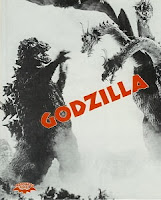 GODZILLA (0913940755 Paperback / 0913940682 Library Bound; 1977 / 1982 / 1986). Toho Studios' most famous monster, Godzilla, is among the original six in the Crestwood House Monsters Series and is one of the more entertaining of the lot. Author Ian Thorne takes on the big lizard with so much fervor that we actually have fun not only in reading about the creature's exploits, but also in learning about the film company and the people who created this much loved movie franchise. The world of Godzilla is a cautionary one that brings to consciousness the dangers and consequences of mishandling atomic weapons. The tale of the green giant awakened from its long slumber by means of H-bomb testing, and the monster's destruction of Tokyo, is recounted from its first cinematic appearance in (the American film version) Godzilla: King of the Monsters! (1956). Many action-packed movie stills accompany the story before we move on to the Godzilla sequels that pitted the temperamental quasi-dinosaur against Angorus, Ghidrah, Gigan, Megalon, Hedorah, Mechagodzilla, and King Kong! As to be expected, Godzilla's son, Minya, and her tentative friends, Rodan and Mothra, also make appearances. Thorne actually dedicates a generous amount of pages to the retelling of both Rodan (1956) and Mothra (1961) films.
GODZILLA (0913940755 Paperback / 0913940682 Library Bound; 1977 / 1982 / 1986). Toho Studios' most famous monster, Godzilla, is among the original six in the Crestwood House Monsters Series and is one of the more entertaining of the lot. Author Ian Thorne takes on the big lizard with so much fervor that we actually have fun not only in reading about the creature's exploits, but also in learning about the film company and the people who created this much loved movie franchise. The world of Godzilla is a cautionary one that brings to consciousness the dangers and consequences of mishandling atomic weapons. The tale of the green giant awakened from its long slumber by means of H-bomb testing, and the monster's destruction of Tokyo, is recounted from its first cinematic appearance in (the American film version) Godzilla: King of the Monsters! (1956). Many action-packed movie stills accompany the story before we move on to the Godzilla sequels that pitted the temperamental quasi-dinosaur against Angorus, Ghidrah, Gigan, Megalon, Hedorah, Mechagodzilla, and King Kong! As to be expected, Godzilla's son, Minya, and her tentative friends, Rodan and Mothra, also make appearances. Thorne actually dedicates a generous amount of pages to the retelling of both Rodan (1956) and Mothra (1961) films. KING KONG (0913940763 Paperback / 0913940690 Library Bound; 1977 / 1978 / 1982 / 1986). More than half of the book's modest length is utilized to cover the epic tale of RKO Radio Pictures' 1933 King Kong. A generous number of movie stills accompany the story of the famous great ape -- his battles with prehistoric creatures on Skull Island and his destructive rampage across the city of New York. Afterward, readers learn about the film's origins and the people (Merian C. Cooper, Marcel Delgado, Willis O'Brien) behind the making of this great monster classic. Other "King Kong" movies are discussed -- Son of Kong (1933), King Kong vs. Godzilla (1962), King Kong Escapes (1967) -- as well as a comparative evaluation of the much-publicized Dino De Laurentiis remake of 1976. Although King Kong is most definitely among the ranks of famous movie monsters, he wasn't the only great ape to dominate the screen. Here, author Ian Thorne takes the opportunity to introduce young readers to various "ape" themed films, such as Murders in the Rue Morgue (1932), The Ape Man (1943), Return of the Ape Man (1944), Mighty Joe Young (1949), Konga (1961), Planet of the Apes (1968), Beneath the Planet of the Apes (1970), Escape from the Planet of the Apes (1971), Conquest of the Planet of the Apes (1972), Battle for the Planet of the Apes (1973), and the 1974 TV series Planet of the Apes!
KING KONG (0913940763 Paperback / 0913940690 Library Bound; 1977 / 1978 / 1982 / 1986). More than half of the book's modest length is utilized to cover the epic tale of RKO Radio Pictures' 1933 King Kong. A generous number of movie stills accompany the story of the famous great ape -- his battles with prehistoric creatures on Skull Island and his destructive rampage across the city of New York. Afterward, readers learn about the film's origins and the people (Merian C. Cooper, Marcel Delgado, Willis O'Brien) behind the making of this great monster classic. Other "King Kong" movies are discussed -- Son of Kong (1933), King Kong vs. Godzilla (1962), King Kong Escapes (1967) -- as well as a comparative evaluation of the much-publicized Dino De Laurentiis remake of 1976. Although King Kong is most definitely among the ranks of famous movie monsters, he wasn't the only great ape to dominate the screen. Here, author Ian Thorne takes the opportunity to introduce young readers to various "ape" themed films, such as Murders in the Rue Morgue (1932), The Ape Man (1943), Return of the Ape Man (1944), Mighty Joe Young (1949), Konga (1961), Planet of the Apes (1968), Beneath the Planet of the Apes (1970), Escape from the Planet of the Apes (1971), Conquest of the Planet of the Apes (1972), Battle for the Planet of the Apes (1973), and the 1974 TV series Planet of the Apes! MAD SCIENTISTS (0913940771 Paperback / 0913940704 Library Bound; 1977 / 1978). Evil and insane seekers of forbidden knowledge -- mad mad MAD doctors! Their unorthodox experiments and the inevitable devastating results are the topic of discussion in this entry in the Crestwood House Monsters Series. The book is divided into three chapters, the first being the story of the superb 1931 film version of Dr. Jekyll and Mr. Hyde, starring Fredric March. Much more condensed is the recap of The Invisible Man (1933) in the following chapter. The third and final chapter -- MORE MAD SCIENTISTS -- provides a brief synopsis for each of the following films in the genre: Frankenstein (1931), Island of Lost Souls (1932), The Mask of Fu Manchu (1932), The Invisible Ray (1936), The Man They Could Not Hang (1939), Dr. Cyclops (1940), Revenge of the Zombies (1943), Tarantula (1955), and The Fly (1958). Also, horror icon John Carradine, is given notable mention.
MAD SCIENTISTS (0913940771 Paperback / 0913940704 Library Bound; 1977 / 1978). Evil and insane seekers of forbidden knowledge -- mad mad MAD doctors! Their unorthodox experiments and the inevitable devastating results are the topic of discussion in this entry in the Crestwood House Monsters Series. The book is divided into three chapters, the first being the story of the superb 1931 film version of Dr. Jekyll and Mr. Hyde, starring Fredric March. Much more condensed is the recap of The Invisible Man (1933) in the following chapter. The third and final chapter -- MORE MAD SCIENTISTS -- provides a brief synopsis for each of the following films in the genre: Frankenstein (1931), Island of Lost Souls (1932), The Mask of Fu Manchu (1932), The Invisible Ray (1936), The Man They Could Not Hang (1939), Dr. Cyclops (1940), Revenge of the Zombies (1943), Tarantula (1955), and The Fly (1958). Also, horror icon John Carradine, is given notable mention. THE WOLF MAN (091394078X Paperback / 0913940712 Library Bound; 1977 / 1978 / 1985). This time, the spotlight falls on the Wolf Man, another famous monster from Universal Pictures. In addition to the retelling of the classic 1941 film of the same name, we are also treated to an adaption of Werewolf of London (1935). Further reading explores the origin of the werewolf in folklore and mentions the first werewolf film ever made -- The Werewolf (1913). Following the chapters on The Wolf Man and Werewolf of London, a brief synopsis is given for werewolf themed films: Frankenstein Meets the Wolf Man (1943), House of Frankenstein (1944), House of Dracula (1945), Bud Abbott and Lou Costello Meet Frankenstein (1948), I Was a Teenage Werewolf (1957), The Boy Who Cried Werewolf (1973), and, finally, The Curse of the Werewolf (1961).
THE WOLF MAN (091394078X Paperback / 0913940712 Library Bound; 1977 / 1978 / 1985). This time, the spotlight falls on the Wolf Man, another famous monster from Universal Pictures. In addition to the retelling of the classic 1941 film of the same name, we are also treated to an adaption of Werewolf of London (1935). Further reading explores the origin of the werewolf in folklore and mentions the first werewolf film ever made -- The Werewolf (1913). Following the chapters on The Wolf Man and Werewolf of London, a brief synopsis is given for werewolf themed films: Frankenstein Meets the Wolf Man (1943), House of Frankenstein (1944), House of Dracula (1945), Bud Abbott and Lou Costello Meet Frankenstein (1948), I Was a Teenage Werewolf (1957), The Boy Who Cried Werewolf (1973), and, finally, The Curse of the Werewolf (1961). THE MUMMY (0896861899 Paperback / 0896861864 Library Bound; 1981 / 1982 / 1986). Considering the popularity of the original six books in the series, it's not surprising that Crestwood House wanted to expand the collection with even more movie monsters. The Mummy, of course, was the perfect choice for sustaining the reading interests of young monster fans. Author Ian Thorne continued lending her writing talents, while Dr. Howard Schroeder was credited as editor for The Mummy and all the new book entries that followed. As usual, the book begins with the retelling of a classic monster film. In this case, Universal Pictures' 1932 chiller The Mummy. Most of the book focuses on the story of Im-ho-tep, the first "Mummy" of the Universal franchise, played by Boris Karloff. Afterward, readers follow the exploits of cinema's most recurring mummy of them all -- Kharis -- in The Mummy's Hand (1940), The Mummy's Tomb (1942), and The Mummy's Ghost (1944). Unfortunately, the author now seems to suffer from a lack of enthusiasm and briefly mentions The Mummy's Curse (1944), Bud Abbott and Lou Costello Meet the Mummy (1955), and The Mummy (1959) collectively in the final textual page. Giving the author due credit, she does provide an interesting account of the 1922 discovery of King Tutankhamen's tomb and the legendary curse attached to it.
THE MUMMY (0896861899 Paperback / 0896861864 Library Bound; 1981 / 1982 / 1986). Considering the popularity of the original six books in the series, it's not surprising that Crestwood House wanted to expand the collection with even more movie monsters. The Mummy, of course, was the perfect choice for sustaining the reading interests of young monster fans. Author Ian Thorne continued lending her writing talents, while Dr. Howard Schroeder was credited as editor for The Mummy and all the new book entries that followed. As usual, the book begins with the retelling of a classic monster film. In this case, Universal Pictures' 1932 chiller The Mummy. Most of the book focuses on the story of Im-ho-tep, the first "Mummy" of the Universal franchise, played by Boris Karloff. Afterward, readers follow the exploits of cinema's most recurring mummy of them all -- Kharis -- in The Mummy's Hand (1940), The Mummy's Tomb (1942), and The Mummy's Ghost (1944). Unfortunately, the author now seems to suffer from a lack of enthusiasm and briefly mentions The Mummy's Curse (1944), Bud Abbott and Lou Costello Meet the Mummy (1955), and The Mummy (1959) collectively in the final textual page. Giving the author due credit, she does provide an interesting account of the 1922 discovery of King Tutankhamen's tomb and the legendary curse attached to it. CREATURE FROM THE BLACK LAGOON (0896861902 Paperback / 0896861872 Library Bound; 1981 / 1982). This time around, Thorne delivers an exciting tale based on yet another great monster flick from Universal Pictures -- Creature from the Black Lagoon (1954). Also included are the plots for its two sequels: Revenge of the Creature (1954) and The Creature Walks Among Us (1956). Equally fun reading is the end chapter, "THE MAKING OF THE CREATURE", which provides interesting information on the construction of the Gill-Man suit and of the two men who played the creature -- Ben Chapman and Ricou Browning. Moreover, we explore the world of 3-D films and its popularity during the 1950s. Sadly, this marks the last book in the Crestwood House Monsters Series in which author Ian Thorne provides insightful information on monster movies and their origins. The books that are later added to the series are simply straightforward story adaptions of the films they're based on. However, for those young readers who did not have the opportunity to see these creature features, reading about them was the next best thing... and they were loaded with rare movie stills you weren't likely to see anywhere else.
CREATURE FROM THE BLACK LAGOON (0896861902 Paperback / 0896861872 Library Bound; 1981 / 1982). This time around, Thorne delivers an exciting tale based on yet another great monster flick from Universal Pictures -- Creature from the Black Lagoon (1954). Also included are the plots for its two sequels: Revenge of the Creature (1954) and The Creature Walks Among Us (1956). Equally fun reading is the end chapter, "THE MAKING OF THE CREATURE", which provides interesting information on the construction of the Gill-Man suit and of the two men who played the creature -- Ben Chapman and Ricou Browning. Moreover, we explore the world of 3-D films and its popularity during the 1950s. Sadly, this marks the last book in the Crestwood House Monsters Series in which author Ian Thorne provides insightful information on monster movies and their origins. The books that are later added to the series are simply straightforward story adaptions of the films they're based on. However, for those young readers who did not have the opportunity to see these creature features, reading about them was the next best thing... and they were loaded with rare movie stills you weren't likely to see anywhere else.FRANKENSTEIN MEETS WOLFMAN (0896861910 Paperback / 0896861880 Library Bound; 1981). Ian Thorne adapts the story of the 1943 film Frankenstein Meets the Wolf Man. The tale is divided into four chapters -- WHEN THE MOON WAS FULL; THE SEARCH FOR FRANKENSTEIN; FRANKENSTEIN'S DAUGHTER; TRAGEDY AT THE CASTLE -- and includes 32 movie stills, three of which were provided by Forrest J. Ackerman.
THE DEADLY MANTIS (0896862178 Paperback / 0896862143 Library Bound; 1981 / 1982). Five chapters -- TROUBLE IN THE ARCTIC; THE MYSTERY DEEPENS; MENACE FROM THE PAST; THE MANTIS FLIES SOUTH; THE MANTIS IN NEW YORK -- within the book, help tell the entire story of the 1957 sci-fi motion picture The Deadly Mantis. Forrest J. Ackerman contributed nine of the film images out of the book's total 30 illustrations.
IT CAME FROM OUTER SPACE (089686216X Paperback / 0896862135 Library Bound; 1982). This is the last book in the series to be written by Ian Thorne and tells the story of the 1953 sci-fi classic It Came from Outer Space. The four chapters are titled: CRASH OF THE STAR SHIP; THE SHAPE-CHANGERS; AT THE OLD MINE; and ESCAPE FROM A HOSTILE PLANET. A total of 31 movie stills are featured, eight of which were provided by Forrest J. Ackerman. The book also marks the last of Ackerman's photo contributions.
THE INVISIBLE MAN (0896863077 Library Bound; 1986 / 1987). Having already written books for Crestwood House's new spin-off book series, "Movie Monsters", authors William R. Sanford and Carl R. Green take over the writing duties to help finish the last three remaining books in the original "Monsters Series" collection after Ian Thorne left to pursue other projects. Dr. Howard Schroeder continued to edit both series. Here, the story of Universal Picture's 1933 film The Invisible Man follows a brief PROLOGUE about the origin and making of this highly entertaining horror/sci-fi chiller. 20 movie stills illustrate the ten short chapters: A STRANGER ARRIVES; WHERE IS DR. GRIFFIN?; THERE'S NOTHING UNDER THOSE BANDAGES!; KEMP MEETS THE INVISIBLE MAN; GRIFFIN TELLS HIS STORY; HOW DO YOU CAPTURE AN INVISIBLE MAN?; "THE WORLD IS MY HIDING PLACE"; THE INVISIBLE MAN TAKES HIS REVENGE; THE INVISIBLE MAN KEEPS HIS PROMISE; and DEATH IS THE ONLY CURE.
THE MURDERS IN THE RUE MORGUE (0896863085 Library Bound; 1987). Authored by William R. Sanford and Carl R. Green, this adaption of the 1932, Edgar Allan Poe-inspired, celluloid chiller features over 18 movie stills published throughout the book's nine chapters: A FIGHT TO THE DEATH; THE MYSTERY IN THE CITY MORGUE; THE BEAST WITH A HUMAN BRAIN; SPOTS IN THE BLOOD AND A NEW HAT; MAKE SURE YOUR DOOR IS BOLTED!; CAMILLE HAS MIDNIGHT VISITORS; MURDER IN A LOCKED ROOM; DOCTOR MIRAKLE'S FINAL EXPERIMENT; A CHASE ACROSS THE ROOFTOPS OF PARIS. There is also a short PROLOGUE that provides a brief introduction to Edgar Allan Poe and his mystery tale the film and this book are based on.
THE PHANTOM OF THE OPERA (0896863093 Library Bound; 1987). Sadly, this is the last book in the Monsters Series. The final story adaption is from the 1943 sound film Phantom of the Opera, which starred Claude Rains. The book's single-page PROLOGUE informs young readers about Gaston Leroux's famous novel and explains the differences between this movie version and that of the earlier 1925 silent film, which featured Lon Chaney as the Phantom. There are 18 movie stills in all and the ten chapters are titled: CHRISTINE MUST MAKE A CHOICE; CLAUDIN LOSES HIS JOB; A TERRIBLE MISUNDERSTANDING; ESCAPE INTO THE SEWERS; CHRISTINE HAS A MYSTERIOUS NEW FRIEND; BIANCAROLLI SEEKS REVENGE; IN PURSUIT OF THE PHANTOM; A TRAP IS SET FOR THE PHANTOM; A PLAN MISFIRES; and THE PHANTOM PLAYS HIS LAST SCENE.







